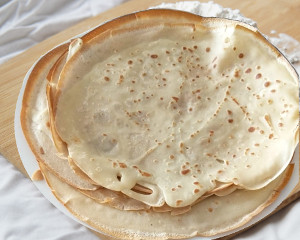Good old crêpes
Posted on

Pancakes — or crêpes — are fun, tasty and social. They are very common in France and every household has their little secret touch that supposedly makes their version unique. And this is the great thing with crêpes: they give you so much freedom that you can really own your recipe. If you don’t know where to start in all this diversity, I kindly suggest to try out my implementation. It usually receives very good feedback and lets you innovate from there on.
Ingredients
- 250g of flour
- 500mL of milk
- 3 eggs
- 1 table spoons of oil (optional)
- 1 table spoon of sugar (optional)
- 1 sip of rum (optional)
Preparing the batter
Pour the flour and sugar into a big salad bowl and dig a little crater. Stir the eggs aside and add it in the middle.
Then add the milk little by little while stirring with a whisk in the middle. Do not actively fetch the flour on the sides and instead let it come progressively. When you poured about half the milk, make sure you have a thick homogeneous mix and whisk it vigourously: It’ll create enough movement within the batter to break the lumps, which would be much harder to do once it becomes more liquid. Then keep pouring and mixing the rest of the milk. The consistency should be relatively fluid for French-style pancakes (wide and thin).
Also add the oil and the rum. Now some might ask if the rum is safe when planning to serve it to children: Yes it is. Because the alcohol evaporates while cooking, no risk of anyone getting tipsy from the pancakes.
Now is time to let the batter rest. The longer the better, one night in the fridge is known to have the best results. This is meant to give time to micro grains of flour to suck the surrounding liquid. Now if you are in a rush: you can also simply start cooking, the result will still be fine.
Cooking time!
Generously warm up a pan. The oil inside the batter should be enough, so no need to oil the surface. Pour one scoop of batter onto the pan and spread it around. The gravity should be enough but you can help it using a spatula if necessary. Wait until you see the sides of the pancake getting colored and lifting away from the pan. You can then start to use the spatula to gently unstick it from the entire surface. Now is time to flip it, either with the spatula or with a firm wrist movement if you feel lucky. Let it cook on the other side for one minute or so before repeating the process until you exhaust the batter.
Important note: keep stirring the batter in the salad bowl between each crêpe as its various ingredients, and most importantly the oil, have a tendency to split apart when resting.
Extra tips and variations
Get the right pan: while many people have endless arguments about the milk/flour ratio or the number of eggs, they often forget that having the right pan will in most cases make the difference between success and failure. A good and well-maintained non-adhesive flat pan will make spreading the batter, getting the right cooking, and flipping the crêpes a walk in a park. Choose wisely and if nothing ideal is at hand, try to gently oil the frying pan to reduce stickiness. Also make sure that your pan is hot enough when dropping the batter: the lack of thermal shock at the contact surface is often the reason why the first pancake is missed.
Beer flavoured crêpes are considered to have a light and mellow consistency, mostly due to the gas bubbles that the beer yields. Simply replace up to half of the milk with some blond beer. The yeast also gives a very good taste, and as a nice side-effect you can then finish the bottle yourself while cooking. I never dared putting both beer and rum into the same batter, but one needs to try!
Sugar or not sugar, that is the question. I would say that adding sugar into the batter is far from mandatory, as toppings such as jam, hazelnut-flavoured chocolate spread, maple syrup, or… sugar, will add the desired sweetness to the final product. But I still think that a mildly sweet batter makes a nice difference. If you plan to add salty toppings however — be it eggs, ham, cheese, etc — DO NOT use sugar: it would definitely not combine nicely.
Watching your diet? There are several ways to make the batter lighter and more digest with very minor impact on the final taste, if at all. With no surprise, you can discard the sugar in the batter. Then, the usual cow milk can be easily replaced with vegetarian milk from rice or soy. I am now using rice milk every time and can honestly not tell the difference. But milk can also easily be replaced by water up to 50%, the crêpes will feel much lighter and still behave as expected on the pan! The wheat flour itself can also replaced by corn flour either partially or totally, which will output nice mellow crêpes ♥.
Last, but not least, the bottle trick that I learned from my youth with the scouts: If you pour the batter into a glass or plastic bottle using a funnel, it can be used to store it efficiently in the fridge while resting, and also to directly pour it onto the pan. Very convenient also when you want to make several crêpes “sessions” from one batch. Again, make sure to shake it generously to get the mix homogeneous before cooking.